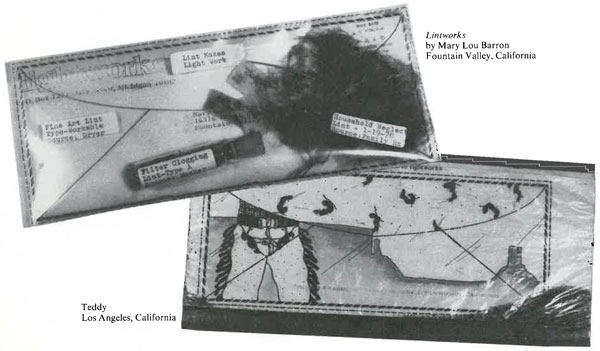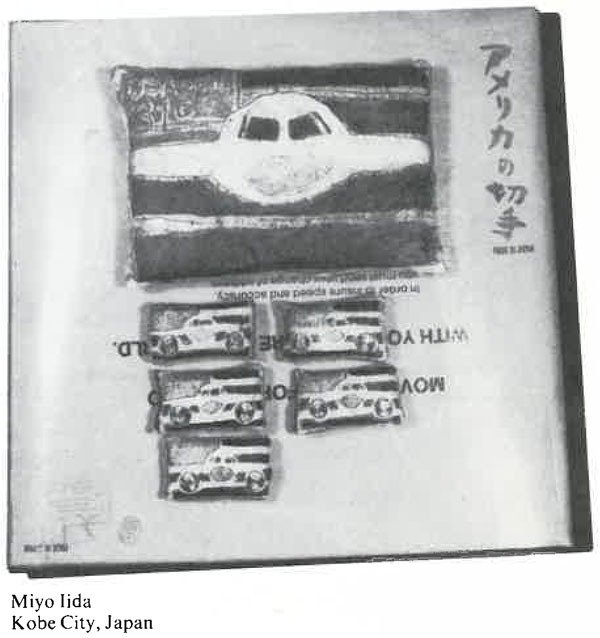An Introduction to the Lightworks Envelope Show
Burch, Charlton: An Introduction to the Lightworks Envelope Show, in: Lightworks Envelope Show. An Exhibition Catalog of Correspondence Art, Lightworks Magazine, Ann Arbor, Michigan, USA, 1979 (Ed. by: Burch Charlton)

Despite rising postal costs, ad hoc facilities, low budgets, and a usual policy of no returns of artwork, correspondence art exhibitions are flourishing. Perhaps this proliferation of shows is possible because of the increasing number of artists who are intrigued by the possibility of exposing their work through such an open-ended public forum as the world postal system. Also, correspondence artists probably enjoy being part of a new art form which consists of a large and intangible creative "network."
However, the role of artist/participant remains largely an imagined one. Because, unfortunately, art sent through the mail to exhibitions often receive little or no response to the contributors. Additionally, the artist ha virtually no control over the way his work is displayed simply because of the distances between the show and the artists. Nevertheless, invitations to participate in correspondence exhibitions are on the rise, summoning the interest of an increasing number of artists willing to share their art via the mail with each other and with the public.
Usually the organizers of the exhibitions choose a theme and/or format for submissions to the show. As mail art tends to be chaotic and exploratory, a theme provides a convenient centering point for the viewing public and creates a more cohesive exhibition.
Lightworks magazine, in organizing and presenting the "Envelope Invitational" exhibit, utilized a drawn image of an envelope approximately the size of a standard No. 10 business envelope. This image was chosen for the simplicity of presentation and format as well as for its role "in reality." As a playful trompe d'oeil, this postcard of the envelope image was mailed with invitation to 500 artists within the mail art "network." Participants were asked to graphically treat the envelope image in whatever fashion they wished and to return it for subsequent exhibition. Three hundred works arrived from about 250 artists. The exploratory and innovative aspect of correspondence art is visible in the widely varied imaging techniques received by Lightworks.
One artist, Steve Durland, used latex cement to create several orderly rows of transparent drippings on the envelope, behind which he rubber stamped red descending ducks.
Slatter Barron's Ligtworks incorporates an image of the envelope on transparent plastic, filled with household lint, labeling various types of dirt and their original locations.

Teddy, of Los Angeles, created a tableau. Filling a plastic bag with sand, he placed the envelope decorated with appropriate cowboy and desert imagery inside. The viewers may shake his object to create their very own duststorm.
While rubber stamps and collage remain often used "tool of the trade," such processes as photography, xerography, sewing and offset printing were also used -Media was everything from oil paint, fabric and gesso to "air cap" packing materials.
Simon Anderson and Rebecca Michaels made multiple editions of the envelope image to be distributed to viewers. Michaels reduced a series of twelve postcards to fit, superimposed on the envelope.
Two Japanese contributions were particularly striking: Takao Kurioka stuffed and sewed plastic sheeting into the envelope shape. Below it, he sewed another pocket containing photographs of other stuffed works and his calling cards inviting future correspondence. Miyo Iida drew and printed intricate lithographs resembling Japanese and U.S. Airmail postage stamps of about actual size. These were mounted and stuffed to accompany the envelope.

Some artists attached razor blades to the envelope or locks of hair. One envelope, by L. E. Coleman, had an unused lottery ticket glued to it. Strangely enough, this was the only piece to be stolen from the exhibition.
Correspondence art i decidedly egocentric. Perhaps this is a reflection of the "Selfish Seventies,” or perhaps simply the release of pressure to communicate and somehow to express who and what one is. Suzanne Lacy' wonderful collage documents her travels with a paint-by-numbers kit of the Mona Lisa. Gerhard Theewen sent pictures of 1950's artifacts with his diary-like notations about his desire to dress like a "Teddyboy." Pat Larder, with her pseudopod of OPU LEGS. mailed a pornographic parody with a photo of her in front of an outhouse. Perhaps the most gruesome, was the imagery of Stelarc of Japan where the artist has sent a photodocumentation of his suspension in the air by hooks pierced through his skin.
A number of submissions used language -words -as their medium, either visually or poetically. Joel Lipman's Poemve/opes used concrete language, overlapped in brightly colored inks through the technique of rubber stamping. R. D. Schroeck rubber stamped the word "idea" repeatedly, forming a little mountain of lush and subtle colors on his envelope. Peter Frank presented hi en tropic little poem, "Return to Sender." Martha Haslanger covered her envelope with mantra-like phrases echoing various aspects of the word "enclosure" and "within." An Italian, A Augusto Concato, touches on the visual paradox of a postcard that looks like an envelope. He writes, "My communication is inside. Open and answer me, please."
Variation of approach are seemingly endless, often defying description. The exhibition represents a celebration of exuberance and imagination and is a profound indicator of what can happen when creativity is given structured freedom. It must be seen to be believed. Regrettably, our photo documentation in this catalog must be defined by what works could be best reproduced given the limitations of our printing process. Still, it is another effort to document and preserve an inspiring and fascinating use of the mail as carriers of art -a testament to the inventive and sharing spirit of the artists who actualize this cultural experience.
Charlton Burch
April, 1979
